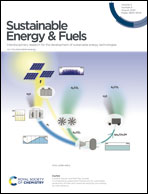Influence of polytetrafluoroethylene (PTFE) on photovoltaic performance and perovskite solar cell stability
Abstract
Hybrid organic–inorganic perovskites have attracted tremendous attention for solar cell application due to their outstanding properties. However, further studies are still needed to fully address the carrier recombination issue at grain boundaries which lowers the device performance, and its environmental stability issues. Fluoride additive engineering is found to be a good method to successfully passivate defects in perovskite films. Here, we developed a simple method to improve the device power conversion efficiency as well as its environmental stability, by introducing the polytetrafluoroethylene (PTFE) additive within the perovskite organic precursor in a two-step deposition method. The built-in electric field effect induced by PTFE induces the migration of photo-generated carriers, suppressing the electron–hole recombination, thus improving the short circuit current and then the photovoltaic performance. We obtained a maximum efficiency of 20.48% for PTFE 5%-based PSCs compared to the pristine one which was only 14.27%. Furthermore, it is also demonstrated that the PTFE-based PSC device exhibits strong environmental stability. The device presented only 5% PCE loss over 42 days of storage in an ambient environment.



 Please wait while we load your content...
Please wait while we load your content...